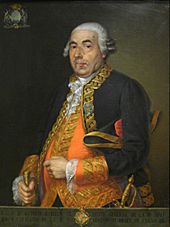Bombardment of Algiers (1784) facts for kids
Quick facts for kids 2nd Bombardment of Algiers |
|||||||
|---|---|---|---|---|---|---|---|
| Part of the Spanish-Algerian war (1775–1785) | |||||||
 Algiers' harbour. Engraving from 1690. |
|||||||
|
|||||||
| Belligerents | |||||||
|
|||||||
| Commanders and leaders | |||||||
| Strength | |||||||
| 9 ships of the line 11 frigates 14 xebecs 90 smaller warships |
4,000 volunteers 70 galiots and gunboats |
||||||
| Casualties and losses | |||||||
| 1 felucca sunk 1 gunboat destroyed 53 killed 64 wounded |
most of the vessels in the harbour sunk | ||||||
The 2nd Bombardment of Algiers was a big attack on the city of Algiers that happened from July 12 to 21, 1784. A group of ships from Spain, Naples, Malta, and Portugal worked together. Their leader was the Spanish Admiral Antonio Barceló.
They attacked Algiers because it was a main base for the Barbary corsairs, who were like pirates. The goal was to stop these pirates from attacking ships in the Mediterranean Sea. This attack was the second attempt, as a similar one the year before had not worked.
Why the Attack Happened
In 1783, pirates from Algiers attacked Spanish merchant ships. Because of this, a Spanish fleet, helped by Malta, attacked Algiers for eight days. That first attack didn't go well. It cost a lot of money and ammunition but didn't stop the pirates.
Even though some people tried to say the attack was a success, it caused only small damage. The Spanish court even called it a "fireworks show" that was too expensive for how little it bothered the Algerians.
To show they weren't scared, Algerian pirates captured two Spanish ships in September 1783. Algiers then made its defenses stronger. They built a new fort with 50 cannons. About 4,000 volunteer soldiers from the Turkish lands joined them. They also hired European experts to help build more defenses.
Algiers prepared at least 70 ships to fight back. The leader of Algiers, called the Dey, even offered a reward of one thousand gold pieces to anyone who captured a ship from the attacking fleet.
Meanwhile, Admiral Barceló got ready for a new attack in Cartagena. His fleet was very large. It included big warships called ships of the line, smaller ships called frigates and xebecs, and many gunboats. These gunboats carried powerful cannons and mortars.
Other countries also helped pay for this new attack. The Pope, Pope Pius VI, gave money. The Navy of the Kingdom of the Two Sicilies sent ships. The Order of Malta and Portugal also sent their own warships to join the allied fleet.
The Bombardment Begins
On June 28, the allied fleet left Cartagena. They arrived near Algiers on July 10. Two days later, on July 12, at 8:30 AM, the attack started. The Spanish ships began firing their cannons.
They kept firing until 4:20 PM. During this time, they shot about 600 bombs and many cannonballs at the city. The Algerians also fired back with their own bombs and cannonballs. People saw a lot of damage to the city and its defenses, and a big fire started.
The Algerian fleet, which had 67 ships, tried to attack the allied ships. But the allied forces pushed them back and destroyed four Algerian ships. The allied side had very few losses, with only 6 people killed and 9 wounded. Most of these injuries were from accidents with their own bombs. One allied gunboat exploded by accident, killing 25 sailors.
Over the next eight days, the allied fleet launched seven more attacks. The Algerians had placed a line of barges (flat-bottomed boats) with cannons. These barges made it hard for the allied gunboats to get close to their targets.
During one attack, a cannonball from Algiers hit the small boat where Admiral Barceló was directing the bombardment. His boat sank, but he was quickly rescued without harm. He immediately got into another boat and kept leading the attack, showing he wasn't worried.
Finally, on July 21, the allied forces decided to stop the attack. Strong winds made it hard to continue, so Admiral Barceló ordered his fleet to return to Cartagena. They had fired more than 20,000 cannonballs and grenades at Algiers. This caused a lot of damage to the city and sank most of the Algerian ships in the harbor. The allied forces lost 53 men and had 64 wounded, mostly from accidents.
What Happened Next
Even though the bombardment caused a lot of damage, it didn't completely succeed in stopping the pirates. However, it did lead to talks between Algiers and Spain. These talks happened from 1785 to 1787.
The leader of Algiers agreed to make peace with Spain. The first peace agreement was signed on June 16, 1785. A second agreement was signed on June 14, 1786. In this second agreement, Spain agreed to pay 1 million pesos to Algiers as a form of payment for damages. Even after these agreements, small fights and more talks continued for a while.
See also
 In Spanish: Bombardeo de Argel (1784) para niños
In Spanish: Bombardeo de Argel (1784) para niños


